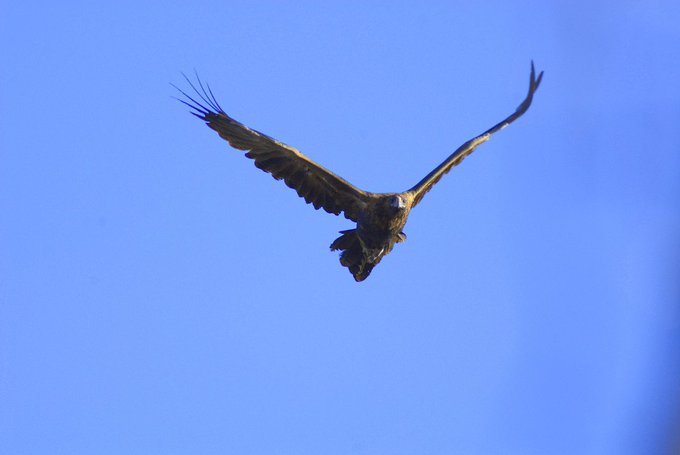Ben Guarino
November 22
November 22

A wedge-tailed eagle over Australia, in what is possibly the first-ever “eagle selfie.”
(Rick Steven)
A Trimble UX5 unmanned aerial vehicle, or UAV, costs about $9,500. It can hit speeds of nearly 60 mph and, from a maximum altitude of 400 feet, snap photographs with 2-centimeter resolution. Pilots who fly the machines prefer the term “UAV” to drone — a typical quadcopter or other consumer drone does not require a five-day operator’s course, after all. To operators like Rick Steven, a surveyor at the St Ives Gold Mine in Kambalda, Western Australia, the UAV technology has become an integral part of the mapping and gold production process.
What the Trimble UX5 cannot do, even when camouflaged with a birdlike paint job, is avoid the devastating talons of Australia’s giant eagles.
“If we see an eagle — protocol is we ditch the mission and land immediately,” Steven told The Washington Post by email. The surveyors are not always so lucky. The wedge-tailed eagle, Australia’s largest bird of prey, can soar up to a mile in the sky. When they descend from such great heights, it is not always possible to react.
The eagles above Kambalda have cost mining company Gold Fields nine of the $9,500 machines, as Steven recently told a conference of open pit miners in Kalgoorlie, Australia.
In one instance, two eagles swooped in on a UAV simultaneously. The first eagle struck the machine from the side. As it spun, the camera took a photo of the second bird. Steven described the image as the “first recorded eagle selfie in history,” according to the Australian Broadcasting Corp.

A surveyor’s UAV camouflaged to look like a bird. (Rick Steven)
It may seem as though birds, whose flying prowess was undisputed for the past 150 million years, would not take kindly to the agile electronic usurpers. That is true for hawks, eagles, falcons and other birds of prey.
“From all indications it’s about defending territory,” Steven said to The Post, “but I have seen them on the ground on top of a downed UAV tearing at it as though they are trying to get food.”
The Wedge-tailed Eagle can weigh 4kg, measure 1m from head to tail-tip & have a wingspan up to 2.3m (Bush Heritage)
Most birds, of course, are not sheep-eating eagles with six-foot wingspans. When flown at a respectful distance, drones and unmanned aerial vehicles can pass birds by, apparently leaving the creatures unperturbed. In a pilot experiment, British ornithologists concluded that mallards, wild flamingos and wading greenshanks “seldom reacted” to a quadcopter drone flying a hundred feet overhead. In fact, experts have used drones to keep an eye in the sky on bird populations. One Cornell University ornithologist monitored crows’ nests via drone; the U.S. Geological Survey researchers counted at-risk sandhill cranes with drones.
But remote vehicles and drones do not escape the fiercest raptors so easily. Guard From Above, a Netherlands-based company, has exploited the hunters’ inclination to knock drones out of the sky. The company trained bald eagles to intercept drones. As of February, Dutch police were mulling the decision to become one of the first forces to deploy anti-drone birds, to the dismay of those who fear carbon-fiber quadcopter blades could harm the birds.
The Kambalda mine surveyors “are doing all that we can” to avoid further eagle strikes, Steven said. “We now fly at an earlier time in the hope that the eagles are still nesting,” he said, “and the heat of the day hasn’t activated the thermal activities that the eagles use to soar and hunt for prey.”
The wedge-tailed eagles’ penchant for hunting drones is not limited to professional UAVs. In 2015, an aerial photographer captured a wedge-tailed eagle on video as it swooped into a drone. The raptors are proficient hunters, witnessed by farmers dropping lambs from a thousand feet to bash open sheep skulls and consume their brains.
The birds are also capable of snatching headlines. In July, an eagle at a wildlife park attacked a young boy in a hoodie, possibly attracted by the motion of the child’s zipper. Another bird grabbed a juvenile kangaroo from the back yard of a police station, as The Post reported in May. An officer rescued the joey and nursed the animal back to health.
Read more at:
https://www.washingtonpost.com/news/morning-mix/wp/2016/11/22/giant-eagles-terrorize-australian-gold-mine-take-selfie-with-drone-camera/

No comments:
Post a Comment